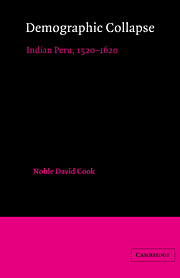Book contents
- Frontmatter
- Contents
- List of tables, figures, and maps
- Preface
- Introduction: The problem in perspective
- Part I Peru's preconquest population
- Part II Demographic collapse
- 8 First contact: north coast
- 9 Center of Spanish control: middle coast
- 10 Disease, earthquakes, and droughts: south coast
- 11 Intermediate area: northern highlands
- 12 Mining and population in the central sierra
- 13 The Indian heartland: southern highlands
- 14 An overview
- Abbreviations used in notes
- Notes
- Bibliography
- Index
- Titles in the series
13 - The Indian heartland: southern highlands
Published online by Cambridge University Press: 02 December 2009
- Frontmatter
- Contents
- List of tables, figures, and maps
- Preface
- Introduction: The problem in perspective
- Part I Peru's preconquest population
- Part II Demographic collapse
- 8 First contact: north coast
- 9 Center of Spanish control: middle coast
- 10 Disease, earthquakes, and droughts: south coast
- 11 Intermediate area: northern highlands
- 12 Mining and population in the central sierra
- 13 The Indian heartland: southern highlands
- 14 An overview
- Abbreviations used in notes
- Notes
- Bibliography
- Index
- Titles in the series
Summary
When the Spaniards arrived there (Cuzco) there was a great number of people; it would have been a pueblo of more than 40,000 vecinos, within the city alone, and what with the suburbs and districts around Cuzco, within 10 or 12 leagues, I believe that there would have been 200,000 Indians, because it was the most densely populated of all these realms.
Cristóbal de Molina, Relatón de muchas cosas acaetidas en el Perú … (1553), P. 33Almost half the Indian inhabitants of Peru, some 600 thousand, lived in the southern highlands in 1570. Many large repartimientos dotted the landscape: About 142 of the 260 holdings of the south sierra had more than a thousand residents. The largest population unit in all Peru, the Crown repartimiento of Chucuito, was composed of almost 75 thousand people at the time of Viceroy Toledo's visita general. Further, the rate of population change for the region was the lowest of all Peru from the 1570s to 1600s: The tributary population declined at only – 1.1 percent annually, and the total population fell at –1.2 percent each year. Thus, the broad outlines of population change in the southern highlands are clear, but the details of the process are still poorly understood. The region is vast: It is almost a country within a country. Many communities made up each repartimiento; we are dealing with more than a thousand such population clusters. It is impossible to study them individually. Once again, we are forced to select some areas and problems to examine in greater depth. The balance must await the results of the ongoing investigation of other researchers.
- Type
- Chapter
- Information
- Demographic CollapseIndian Peru, 1520–1620, pp. 211 - 246Publisher: Cambridge University PressPrint publication year: 1982



